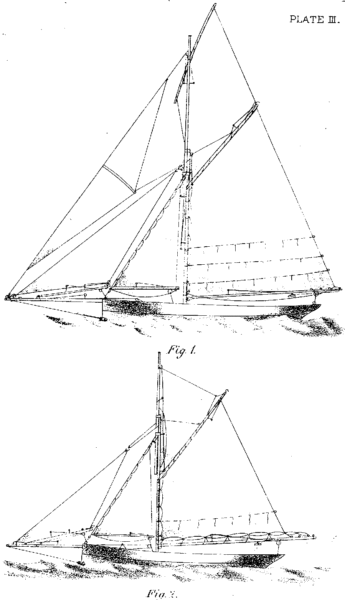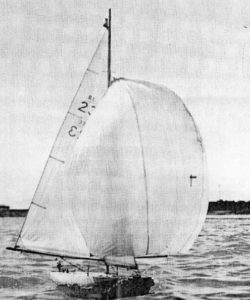History
Model Yachting in the United States
The Early Days
The earliest records we have of organized model yachting date from the middle 1800s in Great Britain. The boats were small, such as the 22-in hull illustrated in Fig. 1. We imagine that the early boats sailed in the United States were similar. By the 1860s there were occasional international contests between model yachtsmen in Great Britain and those in the United States. The only documentation we have is from British periodicals, which naturally covered the events there.
The sail plans for these little boats were quite complicated; in fact, the boats could be thought of as working scale models rather than the specialized competition machines they were to become later. Fig. 2 illustrates the sail plan for the hull given in Fig. 1. It is an example of the “cutter rig” that was popular in full-sized yachts of the time. Owing to the shallow keel and small size of the model, the full rig would be practical only in the kindest of breezes; the lower picture represents what the boat would look like on most days.
These two plans are from a British book by Tyrone Biddle, published in 1879. They are the earliest published plans we have been able to locate. Like many vintage model yacht authors, Biddle documents the practices of a decade or so before his book was published.

Fig. 3. This engraving is from approximately the same period and is one of the
most accurate depictions of boats of that time that we have. Note the details of rig and
hull shape: in particular the extreme range of sizes and classes of rigs.
The Turn of The Century

Fig. 4. Racing from skiffs. Although this picture dates from the early 1920s, the scene could be from 40 or more years earlier.
By the late 1880s the sport was in full swing, principally in the New York City area. There were three clubs there, and they formed the first sanctioning body for interclub races in the United States: the Model Yacht Racing Union of North America. This organization died out, and a national group was not formed again until the early 1920s. The boats of this period were sailed from small, one-man skiffs on large bodies of water. The predominant classes were quite large and heavily canvassed; a typical boat could be 6 feet in overall length and carry 2200 square inches of sail on a 20-pound displacement hull. Although the boats raced at the same time, the race was actually against the clock; the skippers pursued their models in the skiffs, and a penalty was assessed for each time you touched your boat to adjust its trim or course. Collisions, fouls, and protests were common. The plan shown in Fig. 5 is of Emma, a typical boat of the late 1880s. It is an early boat by the celebrated “Admiral” Walter Many.
Around this time the first specialized ponds for model yachting were beginning to appear in public parks. Two of the earliest were in Central Park, in New York (Fig. 6), and Spreckles Lake, in Golden Gate Park, San Francisco (Figs. 7 & 8).

Fig. 7. Here’s an early picture of sailing in San Francisco. A bit of a mystery
surrounds this, as the postcard was postmarked 1911 and Spreckles Lake was not supposed tohave been built until 1916; but the path and “rip rap” banks tend to place the photo at Spreckles. Note the length of pole needed to get the boats clear of the rough bank.
The Roaring 20s

Fig. 9. The two boats that sailed for the first International Championship in 1922. On the left, E.A. Bull of the United States and Polka Dot. On the right, W.J. Daniels of Great Britain and Endeavour.
The 1920s and 1930s were marked by the epic international battles of A class boats. The series, though open to all countries, was mainly between Great Britain and the United States. The first race was won by the United States, largely because of the British unfamiliarity with sailing from skiffs. The subsequent races were from side to side of ponds, at which the British designers and skippers excelled; the United States did not win again until 1948, when Bill Bithell’s Ranger was triumphant. In 1927, John Black’s Bostonia II lost the series by a single point. In his report on the race (published in Yachting magazine), he accused the German skipper of throwing a race in order to increase the point score of the British boat. A heated exchange of correspondence resulted. John Black was later famous for the Cheerio series of M class boats.
The Depression Years and the Marblehead Class

Fig. 12. Spreckles Lake at roughly the same time. This shot is taken from the Southwest corner where the powerboats now operate. At this time it was evidently still possible to sail side to side at Spreckles.
Model Yachting reached a peak of activity in the 1930s. It was a relaxing and relatively inexpensive hobby. Many shop and manual arts classes built boats as class projects, because a model yacht involves woodwork, metal forming and casting, and working with fabrics. In addition, the Works Project Administration of Roosevelt’s New Deal built many ponds in urban areas throughout the United States. One of the finest was at Berkeley, California, where the WPA constructed both a yacht harbor and an Aquatic Park with areas for paddle boats, model speedboats, and model yachts. The model yacht pond was active well into the 1950s, but has now been abandoned.
The Marblehead class was created in the 1930s.
The 1940s
Model yachting enjoyed a resurgence after World War II but never regained its pre-war popularity. The principal classes were the M or Marbleheads, the traditional A boats, and the X class. This latter class was established just before the War, and had the simplest rules of all: 1000 square inches of sail and virtually no restriction on hull design. X boats tend to be long, lean and handsome, and the class was very popular on the West Coast. During the late 1940s the Model Yacht Racing Association of America fell prey to internal strife and the last publication devoted exclusively to the hobby went under. Ironically, one of the last issues announced the most significant event of the era: the winning of the International A Class Championship by Bill Bithell’s Ranger.
The 1950s and 60s
Here is the deck layout of a typical X Class boat of the late 1940s and 1950s. The sliding rig enables the relationship between the center of effort of the sails and the center of resistance of the hull to be adjusted to wind conditions.
One of the most interesting developments of the 1950s were t he “finless fin keel” boats of A.R. Lassel. These were the results of his long study of dynamic balance of free-sailing boats, which also lead him to be one of the leading proponents of the sliding rig. The idea was to move the center of lateral area aft and reduce the wetted surface as much as possible. The photograph to the right shows a hard-chine test hull, probably built to M Class dimensions.
he “finless fin keel” boats of A.R. Lassel. These were the results of his long study of dynamic balance of free-sailing boats, which also lead him to be one of the leading proponents of the sliding rig. The idea was to move the center of lateral area aft and reduce the wetted surface as much as possible. The photograph to the right shows a hard-chine test hull, probably built to M Class dimensions.
Throughout the 1960s the sport went through a gradual decline in popularity that was not reversed until practical radio control, and the American Model Yachting Association, came on the scene in the early 1970s. The emphasis then moved to advanced materials and designs, and the Vintage Era slowly ended.










